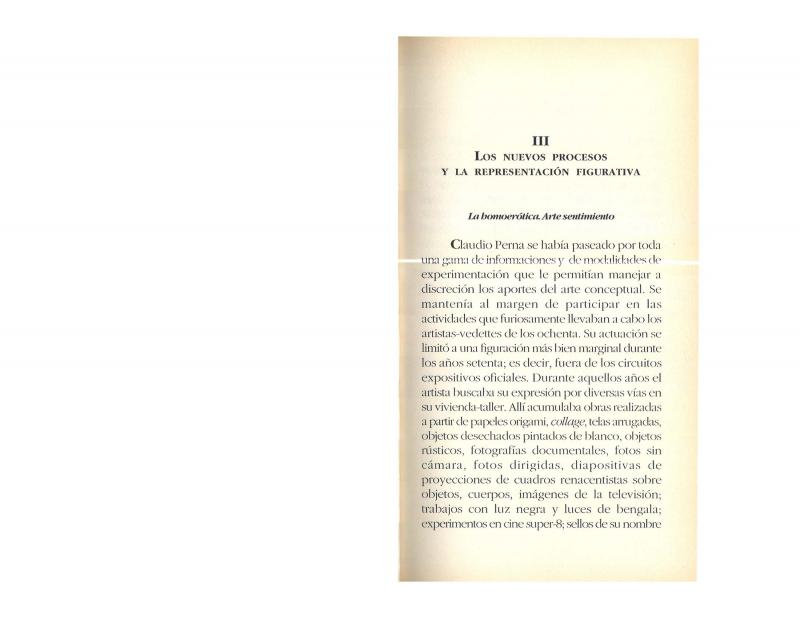Speaking as the researcher who has devoted more time than anyone else to studying and promoting the life and work of Claudio Perna (1938–97), Zuleiva Vivas begins her essay by reiterating the fact that this artist has been virtually ignored by Venezuelan museums. She also mentions how hard it is to classify his work, and describes the various media he used. This essay is interesting because it presents the broad view that Perna, as an artist, a geographer, and a humanist, had about art. Vivas characterizes him as an artist who is “always interested in transcending the limits of conceptual art,” and addresses his main theme—his “Arte-Pensamiento [Thought-Art]”—by describing his personality traits, discussing his interests and, most of all, referring to things he has said that help to explain the philosophical underpinnings of his work and his thinking. “Arte-Pensamiento” was a sort of human, aesthetic, and natural space that facilitated the interrelationship between art and communication, between thought and the written word, between meanings and how to put them in order; in other words, everything involved thoughts, words, diagrams, and images. Vivas says that “re-thinking and re-perceiving were Perna’s favorite sports.” She mentions the artist’s important ideas: we can only face the challenge of changing the “scale” if we expand the foundations of how we “see and experience the world.”
After his death in 1997 Vivas and a group of his close friends created the Fundación Claudio Perna, an organization devoted to the study and promotion of his intellectual legacy and his vast body of work. Based on her thesis about that body of work, Vivas wrote a book, La desaparición de los límites. Claudio Perna: aportes para el estudio del arte latinoamericano actual (Caracas: Fundación Claudio Perna, 2000). Vivas was the promoter and curator of the first major retrospective of Perna’s work in August 2004 at the Galería de Arte Nacional de Caracas: Arte Social. Claudio Perna.
To read other articles about this artist, see by Margarita D’Amico “1: Hoy es arte lo que no era” [doc. no. 1068360]; by Luis Enrique Pérez-Oramas “El autocurrículum de Claudio Perna, escultura social y novela hiperrealista” [doc. no. 1161917]; by Roberto Guevara “Claudio Perna o cómo ser libre en la marginalidad” [doc. no. 1080814]; by Elsa Flores “(Sin título) [Vivir quiere decir dejar huellas…]” [doc. no. 1063156]; by María Elena Ramos “Arte–idea–geografía” [doc. no. 1080766]; by Mara Comerlati “Claudio Perna. Lo fundamental es inventar. Este domingo expondrá más de cincuenta dibujos en la Sala Mendoza” [doc. no. 1068403]; by José Napoleón Oropeza “Claudio Perna. Disfruto el estilo de no tener estilo” [doc. no. 1067382]; and by Lourdes Blanco “Claudio Perna: fotocopias” [doc. no. 1080715]. See also the following articles by Zuleiva Vivas: “Las opciones del tiempo para el nuevo espíritu” [doc. no. 1065674]; “Visión panorámica de las nuevas cartografías” [doc. no. 1157158]; “Los nuevos procesos y la representación figurativa” [doc. no. 1157174]; and “Intervención creativa en el contexto social” [doc. no. 1161969].












